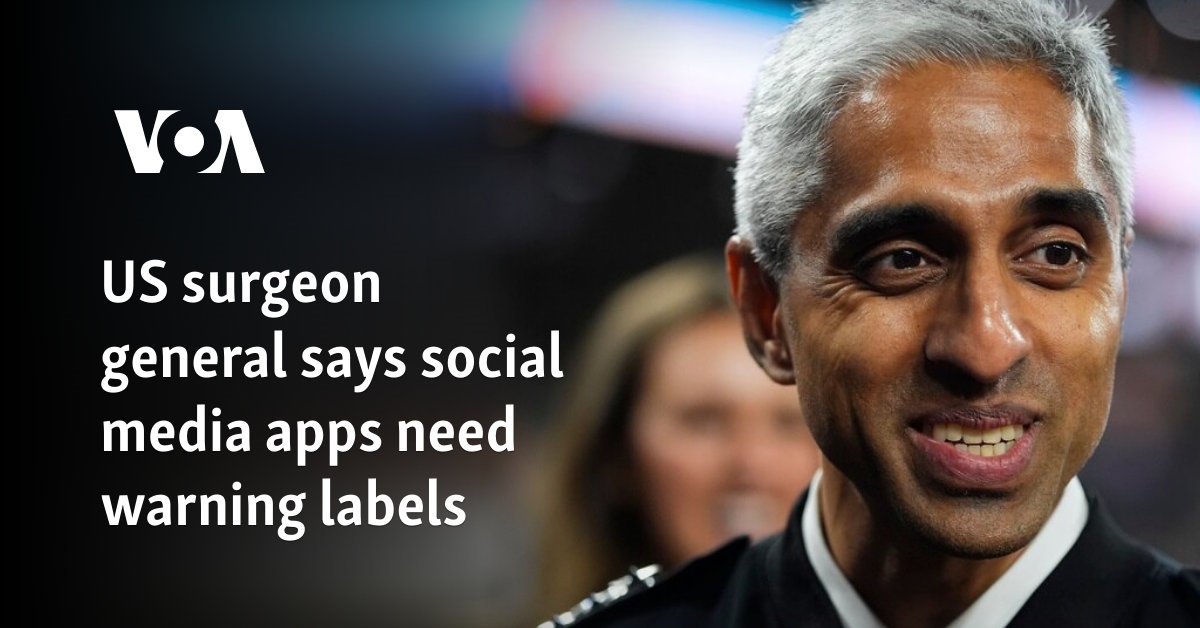The top public health officer in the United States has called for warning labels to be placed on social media applications, advising users — particularly parents of teenagers — that the platforms may damage the mental health of young people.
Surgeon General Dr. Vivek H. Murthy made his case for the warning in an opinion column published Monday in The New York Times, characterizing the issue as a problem that requires immediate action.
“The mental health crisis among young people is an emergency — and social media has emerged as an important contributor,” Murthy wrote. “Adolescents who spend more than three hours a day on social media face double the risk of anxiety and depression symptoms, and the average daily use in this age group, as of the summer of 2023, was 4.8 hours. Additionally, nearly half of adolescents say social media makes them feel worse about their bodies.”
Murthy argued that a “surgeon general’s warning” label should be applied to social media applications similar to those that appear on containers of alcoholic beverages and tobacco products. The warnings spell out the specific risks associated with using both products.
Although Murthy heads the United States Public Health Service Commissioned Corps, he does not have the authority to require companies to adopt such warnings. Such a requirement must be passed by Congress.
In his column, Murthy cited the past benefits of warning labels, which he said “would regularly remind parents and adolescents that social media has not been proved safe. Evidence from tobacco studies show that warning labels can increase awareness and change behavior.”
Other steps
Murthy argued that social media applications are designed to be addictive, using push notifications, autoplay videos and the ability to scroll through a seemingly infinite stream of posts to keep user’s attention on the platform.
Although he did not name any specific applications, the characteristics he described are common to most of the major platforms, including TikTok, Instagram and X.
Murthy conceded that a warning label would not, by itself, be enough to quell what he called the “harms” of social media. He called on the platforms to be more transparent about how they work, on schools to restrict students’ access to smartphones during the school day, and on parents to be vigilant about limiting younger teens’ access to social media.
“The moral test of any society is how well it protects its children,” Murthy wrote. “We have the expertise, resources and tools to make social media safe for our kids. Now is the time to summon the will to act. Our children’s well-being is at stake.”
Growing movement
Murthy’s call for warning labels adds his voice to a growing movement that claims smartphone technology, and especially social media, presents a unique danger to youth.
In March, Jonathan Haidt, a psychologist and New York University professor, published a book, The Anxious Generation: How the Great Rewiring of Childhood is Causing an Epidemic of Mental Illness, which became an immediate bestseller.
While Haidt’s critique of modern childhood is not limited to the use of social media, he concluded that the rise of such platforms has been a major contributor to what he also described as a mental health crisis among young people.
Writing about his research in The Atlantic magazine, Haidt said, “A study of teens in 29 nations found that between 5 and 15 percent of adolescents engage in what is called ‘problematic social media use,’ which includes symptoms such as preoccupation, withdrawal symptoms, neglect of other areas of life, and lying to parents and friends about time spent on social media.”
Extent of harm doubted
While there are many high-profile supporters of the claim that social media is uniquely harmful to teenagers, the sentiment is far from universally shared. Some experts argue that the current wave of alarm about social media is an echo of similar tides of fear that washed over the country after other kinds of new technology were released.
In the early part of the 20th century, there was broad social concern about the impact radio would have on young people, a concern that recurred with even more force with television a few decades later. Panic about the impact of video games also surged in the early part of this century.
“It’s very clearly a moral panic,” Stetson University psychology professor Christopher Ferguson said about the current concern about social media. “Political efforts and lawsuits are creating this narrative, but there’s a wide gulf between that narrative and the actual data that can be used to support it.”
Ferguson said research on mental health in teenagers is far from conclusive when it tries to assess the actual impact the platforms have on younger users, and that some of the data suggest the connections are marginal at best.
He also said that some impacts, such as the documented rise in the suicide rate in the U.S., have not been mirrored in other wealthy Western countries where the adoption of smartphones and social media has happened at a similar rate.







